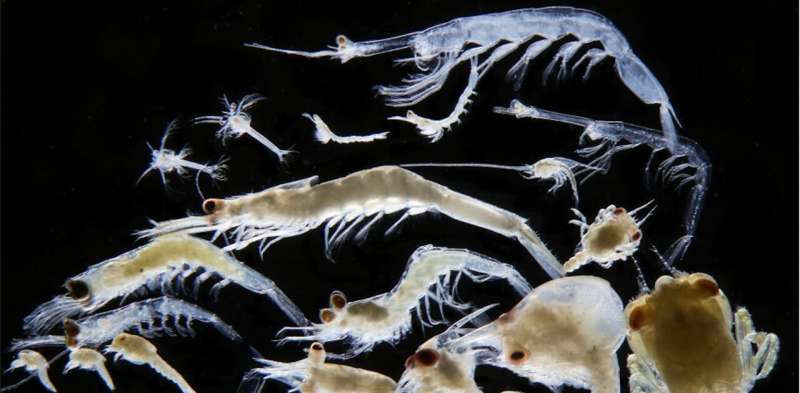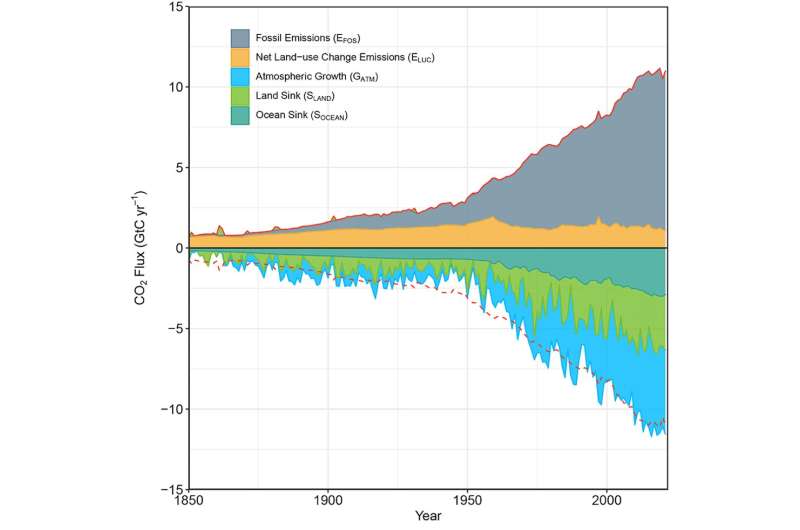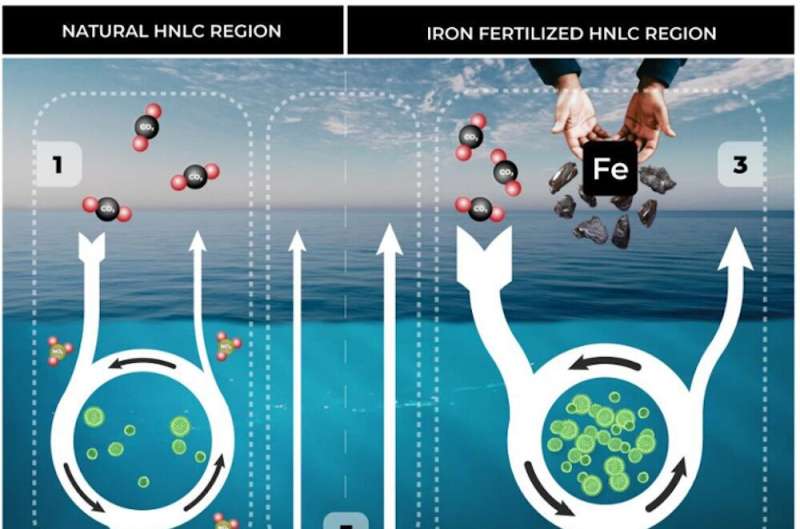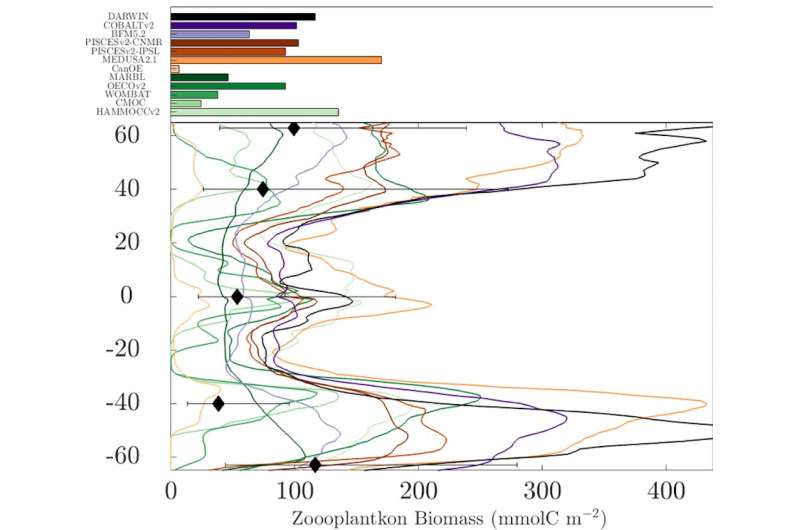This article has been reviewed according to Science X's editorial process and policies. Editors have highlighted the following attributes while ensuring the content's credibility:
fact-checked
peer-reviewed publication
trusted source
written by researcher(s)
proofread
Oceans absorb 30% of emissions, driven by a huge carbon pump: Tiny marine animals are key to cycle, says study

The ocean holds 60 times more carbon than the atmosphere and absorbs almost 30% of carbon dioxide (CO₂) emissions from human activities. This means the ocean is key to understanding the global carbon cycle and thus our future climate.
The Intergovernmental Panel on Climate Change (IPCC) uses earth system models to project climate change. These projections inform critical political, social and technological decisions. However, if we can't accurately model the marine carbon cycle then we cannot truly understand how Earth's climate will respond to different emission scenarios.
In research published in the journal Communications Earth & Environment, we show that zooplankton, tiny animals near the base of the ocean food chain, are likely to be the biggest source of uncertainty in how we model the marine carbon cycle. Getting their impact on the cycle right could add an extra 2 billion tons to current models' assumptions about annual carbon uptake by the ocean. That's more carbon than the entire global transportation sector emits.
Marine carbon cycling is a $3 trillion thermostat
Roughly 10 billion tons of carbon are being released into the atmosphere each year. But the ocean quickly absorbs about 3 billion tons of these emissions, leaving our climate cooler and more hospitable. If we price carbon at the rate the IPCC believes is needed to limit warming to 1.5℃, this adds up to over A$3 trillion worth of emission reductions accomplished naturally by the ocean every year.
However, we know the size of the ocean carbon sink has changed in the past, and even small changes can lead to big changes in the atmosphere's temperature. Thus, we understand the ocean acts as a thermostat for our climate. But what controls the dial?
Extensive geological evidence suggests microscopic marine life could be in control. Phytoplankton photosynthesize and consume as much CO₂ as all land plants.
When phytoplankton die, they sink and trap much of their carbon deep in the ocean. It can remain there for centuries to millennia, locked away safely out of contact with the atmosphere.

Any changes to the strength of this biological carbon pump will be felt in the atmosphere and will change our climate. Some have even proposed enhancing this biological pump by artificially fertilizing the ocean with iron to stimulate phytoplankton. It's possible this could sequester as much as an extra 20% of our annual CO₂ emissions.
Right for the wrong reasons
Despite its importance for the global climate and food production, there are large gaps in our understanding of how the marine carbon cycle is expected to change. Most earth system models differ in how the cycle's major components will respond to a changing climate. Models simply can't agree on what will happen to:
-
net primary production—the carbon consumed by phytoplankton resulting in growth of marine plants at the base of the food web
-
secondary production—zooplankton growth, which is an indicator for fisheries, since fish eat zooplankton
-
export production—the biological pump of carbon transferred to the deep sea.
To diagnose what might be going wrong, we compared the marine carbon cycle in 11 IPCC earth system models. We found the largest source of uncertainty is how fast zooplankton consume their phytoplankton prey, known as grazing pressure.

Models differ hugely in their assumptions about this grazing pressure. Even if zooplankton were exposed to the exact same amount of phytoplankton, the highest assumed grazing rate would be almost 100 times as fast as the slowest rate.
This is because some models effectively assume the ocean is filled entirely with slow-grazing shrimp. Others assume it is teeming exclusively with microscopic, but rapidly grazing ciliates. In reality, neither is true.
Models must make up for such large differences in zooplankton grazing by making additional assumptions about how fast phytoplankton grow and how quickly zooplankton die. Together, these differences can be balanced in a way that allows most models to simulate the present-day amount of carbon consumed by phytoplankton and transferred to the deep sea.
However, that is only because we can observe what those values should be. We can then tune models until we ensure they get the right answer.
Yet, even though our best models can admirably recreate the present-day ocean, they do so for different reasons and with dramatically different assumptions about the role of zooplankton. This means these models are built with fundamentally different machinery. When used to test future emissions scenarios, they will project fundamentally different outcomes.
We cannot know which projections are correct unless we know the true role of zooplankton.

Tiny plankton with a big impact
We ran a sensitivity experiment to show how small changes in zooplankton grazing can dramatically alter marine carbon cycling. We considered two sets of experiments, one control and one in which we increased both zooplankton grazing rates and phytoplankton growth rates, such that both were tuned to the exact same total carbon consumption by phytoplankton.
This increase in how fast zooplankton can graze was only a fraction of the difference between assumed grazing rates seen across IPCC models. Despite this, we found even this small increase led to a huge difference in the percentage of carbon consumed by phytoplankton that was eventually exported to depth and transferred up the food chain.
Ocean carbon storage increased by 2 billion tons per year. Zooplankton carbon consumption increased by 5 billion tons.
From a climate perspective, that is double the maximum theoretical potential of iron fertilization. From a fisheries perspective, that leads to a 50% increase in the size of the global zooplankton population on which many fish feed. This matters for global food supply as the ocean feeds 10% of the global population.
This work shows we must improve both our understanding and modeling of zooplankton. With limited resources and an immense ocean, we will never have enough observations to build perfect models. However, new technologies for measuring zooplankton are making it easier to make autonomous, high-resolution measurements of many important variables.
We must make a concerted effort to leverage these new technologies to better understand the role of zooplankton in the marine carbon cycle. We will then be able to reduce uncertainties about future climate states, advance our ability to assess marine-based CO₂ removal, and improve global fisheries projections.
More information: Tyler Rohr et al, Zooplankton grazing is the largest source of uncertainty for marine carbon cycling in CMIP6 models, Communications Earth & Environment (2023). DOI: 10.1038/s43247-023-00871-w
Journal information: Communications Earth & Environment
Provided by The Conversation
This article is republished from The Conversation under a Creative Commons license. Read the original article.![]()





















